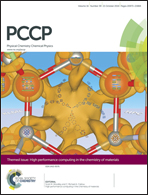Theoretical studies on the quinoidal thiophene based dyes for dye sensitized solar cell and NLO applications†
Abstract
A series of quinoidal thiophene based dye molecules were designed and their optoelectronic properties were studied for dye sensitized solar cell (DSSC) applications. The efficiency of the designed dye molecules was analyzed using various parameters such as the HOMO–LUMO energy gap, absorption spectra, light harvesting efficiency (LHE), exciton biding energy (Eb) and free energy change for electron injection (ΔGinject). The simulated absorption spectra of the quinoidal thiophene molecules show that the electron withdrawing group substituted molecules exhibit dual band characteristics. We found that the cyano-[5′-(4″-amino benzylidene)-5H-thiophen-2′-ylidene] acetic acid based molecules, QT2B, QT4B, QT5 and QT6, are good candidates for DSSC applications. Furthermore, the study on the polarizability and hyperpolarizability of the designed molecules showed that the electron withdrawing group substituted QT2B-X molecules (X = Cl, Br, CF3, CN and NO2) are good candidates for NLO applications.


 Please wait while we load your content...
Please wait while we load your content...